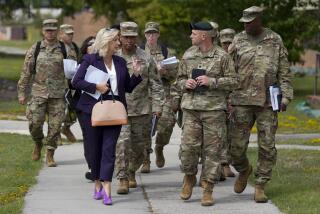Soldier by Day, Online Student by Night
- Share via
WASHINGTON — The Army, hoping to reduce a major barrier to recruiting and retaining talented young people, will announce today a new education program that could enable millions of soldiers to earn college degrees and technical certificates in a global system of online learning.
As envisioned by Army leaders, the new system will offer educational opportunities from a diverse consortium of colleges, universities and technical schools linked by computer technology. Soldiers will be provided with computers, printers and Internet access, including ports to be installed in Army barracks. Funds also will be available for textbooks and fees.
New policies will make it easier for soldier-students to enroll, transfer credits and meet degree requirements. In addition, Army officials said, students will be assigned coaches who will provide career guidance and academic support.
Army University Access On-Line, with a six-year price tag of $550 million, is designed to enable a new recruit--or a longtime soldier--to earn a college degree during a standard four-year enlistment.
And, because the system will be built around online or “distance learning,” students will be able to do classwork from schools of their own choosing no matter where they are stationed, even during peacekeeping deployments in such places as Bosnia.
The program, which officials hope to have up and running by early next year, is aimed at countering widespread concern among potential recruits and their parents that they face a choice between serving in the military and pursuing higher education.
“What we want to do is make it so it’s not an either-or choice. You can learn while you serve,” Secretary of the Army Louis Caldera said in an interview.
The Army also hopes that by helping soldiers--officers as well as enlisted personnel--earn degrees while in the service, it will encourage the best and brightest to stay in uniform longer.
“This is both a recruiting and a retention initiative,” a senior official said.
Amid rising prosperity, greater competition for talent in the job market and increased emphasis on advanced education, the armed services have faced mounting difficulty keeping their ranks filled with high-quality volunteers.
Last year, the Army fell about 6,300 short of its goal of 74,000 new recruits and ended the year at full strength only because of an unusually large number of reenlistments.
Meeting this year’s targets is expected to be equally difficult. Similar problems have plagued the Navy and Air Force.
“Our greatest competition for young people is not the hot economy. It’s higher education,” Caldera said. “Eighty percent of the recruits we value most are going to college. They’re choosing higher education over the military. Even parents in military families are encouraging their kids to go for higher education.”
If they cannot overcome that challenge, the Army and other services face the prospect of bending or lowering standards to accept less capable recruits--something that already has begun to occur, though minimum requirements remain high by historical standards.
In recent years, the armed services have tried to woo able recruits by offering programs similar to the old GI Bill, providing money for education after military service.
But experience has shown that such incentives have lost some of their appeal as scholarships and student loans have become more widely available.
And even if the promise of financial aid draws some recruits into the service, the best of them tend to leave as soon as they can to reap the promised reward, instead of staying in the service.
“The message of the GI Bill in a sense works against us. It says defer education. Parents don’t want to hear that,” said Caldera, who formerly represented downtown Los Angeles in the California Assembly.
He said that Army recruiting messages, targeted at young people, must be aimed at parents too because they exert substantial influence over enlistment decisions.
As a result, the Army has revamped and retargeted its recruitment strategy. Programs have already been launched to help recruits who dropped out of high school earn equivalency certificates and pursue other educational opportunities.
Hopes are particularly high for the online college and technical degrees program because it should encourage soldiers, and perhaps eventually members of their families, to pursue additional education without leaving the service.
Indeed, since going to school part time usually extends the degree-earning process and the Army will be supplying equipment and support as well as tuition subsidies, the program could become a powerful incentive for reenlistment.
“If we can help them meet their personal educational goals while serving, they may be less likely to leave,” Caldera said.
The Army already offers tuition subsidies for soldiers pursuing additional education while in uniform, but would-be students face a host of obstacles.
For one thing, choices of schools and programs are often limited to what is available near a particular base. Also, duty schedules often conflict with class times. And soldiers are moved so often they have trouble completing a course of study or transferring credits to a new school.
A key element of the new program will be its ease of transferring credits and its reduction of other such barriers, officials said.
“We have uncounted thousands of individuals out there who have pieces of degrees and have been unable to put the pieces together,” said a senior Army official involved in designing the new program. “This will enable them to finish what they start.
“And it will give them broader choices. They won’t just be stuck with the institution that happens to be right outside the base.”
The program is budgeted at $48 million this year. By early next year, two or three pilot sites could be serving 15,000 to 20,000 soldiers.
Private contractors will be asked to develop plans this summer for bringing together a wide array of schools already experienced in distance learning, and for supplying the software, Internet links, laptop computers and support services needed to allow soldiers to log onto the system from anywhere in the world during their free time.
Working during off-duty hours, soldiers could earn associate, bachelor’s and master’s degrees or technical certificates in a wide range of subjects.
Technical training is expected to be in particular demand, because private industry is already searching the military’s ranks for such skills.
Since most members of the armed forces complete their military service while relatively young and go on to second careers, many want to be sure they will have marketable skills in the civilian economy.
The Army uses distance learning extensively now for teaching military skills, and some soldiers have taken advantage of computer classes offered by outside institutions.
But this will be the first comprehensive program that offers nonmilitary education and is managed by the service itself.
“This is not a half-step on the Army’s part,” the senior official said. “This is a huge commitment.”
More to Read
Sign up for Essential California
The most important California stories and recommendations in your inbox every morning.
You may occasionally receive promotional content from the Los Angeles Times.










